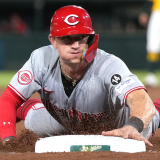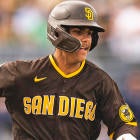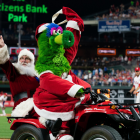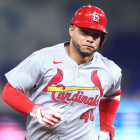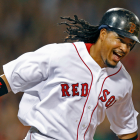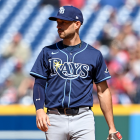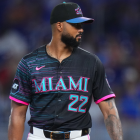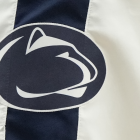Prospect Watch: Five disappointing minor-league seasons, including Yankees outfielder and teenage catcher
With the minor-league season is almost complete

As we wrote last week: "September isn't just the final month of the Major League Baseball season -- it's also the final month of the Minor League Baseball campaign. With that in mind, we're using this and next week's Prospect Watch to sum up the year that was on the farm by highlighting some of the biggest individual surprises and disappointments." We published the biggest surprises half of the equation last week, meaning that this time around, we're focusing on the biggest disappointments.
At the risk of stating the obvious, we're not saying these individuals are now bad prospects. Rather, we considered all the players presented here to be among the top five youngsters in their respective organizations. By including them, we're simply acknowledging that they had worse years than we anticipated. That's all. Sometimes progress isn't linear, no matter how much we wish it were.
Now, with that mumbo jumbo out of the way, let's get to it.
1. Ethan Salas, C, Padres
There's a big difference between acknowledging that a player had a disappointing season and dismissing that player's potential. Salas embodies the distinction. Back in the spring, we felt it was possible that he would become MLB's first teenage catcher since Iván Rodríguez. Salas still may accomplish that feat, but he'll have to wait until 2025 -- or, perhaps, just ahead of his 20th birthday on June 1, 2026.
For those unaware of Salas' backstory, he stormed through the minors last season in what was his first professional campaign. The Padres challenged Salas in a way that's uncommon for players so young, to the extent that he caught in a big-league spring training contest before taking his first official minor-league at-bat. Salas appeared up to the challenge, reaching Double-A and showcasing an advanced defensive game.
Salas started (and will assuredly end) this season at High-A. He posted an OPS above .600 in just two months, with his .737 peak coming in August. Those marks are easier to stomach given a few pieces of context: 1) Salas was playing at a level where he exclusively faced pitchers older than him; 2) he did so at an age where, had he been drafted in July, he would've been considered to be on the younger side, and 3) he did it while catching nearly 600 innings for the first time as a professional.
In a perfect world, Salas would have posted better numbers. In this world? We're not concerned, even if we can acknowledge that this year was something of a letdown.
2. Spencer Jones, OF, Yankees
Jones, 23, has been a fixture on breakout lists for years now; the Yankees were high enough on him that they reportedly refused to trade him for Dylan Cease. It's not hard to understand why. He has elite raw strength, surprising athleticism for his 6-foot-6 frame and proximity to an easy, albeit equally lazy, best-case scenario in Aaron Judge.
Whereas Judge was debuting in the majors at 24, Jones encountered some serious turbulence in Double-A this season that threatened a similar arrival time.
Whenever you have a hitter this large, the main concern is that their swings will be elongated to the point of being exploitable. In turn, that flaw can fuel some absurd strikeout rates. As of this writing, Jones has punched out in nearly 38% of his trips to the plate. Teams are more willing than ever before to ignore a bloated K rate if the other offensive skills are good, but there's a difference between fanning that often in the majors -- something that, mind you, no qualified batter has done this season -- and doing so at Double-A, where Jones is basically at his age-appropriate level.
We don't want to belabor the point, but there comes a time where being a fixture on breakout lists year after year is more of a negative than a positive. For Jones' sake, we're hoping that he doesn't get there.
3. Colson Montgomery, SS, White Sox
If the White Sox were not on pace to shatter the single-season loss record, there would be more focus on Montgomery's brutal year. Back in the spring, he seemed like a sure thing to debut at some point this summer. Instead, he's spent the season in Triple-A, where he's produced some surprisingly subpar numbers and underlying indicators.
Montgomery, 22, struck out nearly 30% of the time and was exploitable up in the zone. He hit a ton of pop-ups as he tried to embrace lifting the ball. He posted some disappointing exit velocity numbers despite nearly touching 114 mph on a May home run (that's uncommon among left-side infielders). And so on.
We don't want to come across as overly negative. Montgomery is still young with promise, and it's fair to note that he missed a lot of last season because of injury. Even so, there's ample reason why he finds himself included in this piece.
4. Mick Abel, RHP, Phillies
If you've read any of our draft coverage in recent years, you know that we like to hammer home the risks of taking a high-school right-hander in the first round. The attrition rates are simply too high. From a probabilistic analysis perspective, you're better off taking a different position, usually a hitter, and getting arms later on. If we're wise to that, teams certainly are, too -- and yet that never stops them.
The Phillies are one of the teams most willing to roll the dice. They chose Abel (now 23 years old), with the 15th pick in the 2020 draft. They then doubled down the following summer, selecting Andrew Painter (who hasn't pitched since 2022 on account of injury) with the 13th pick in 2021. Years on, neither has worked out as hoped.
Abel looked like a favorable candidate to become a middle-of-the-rotation starter. He had the build, the delivery, the arm strength, and the innate ability to spin the ball. Alas, his command has stagnated. Abel spent this season at Triple-A, walking more than six batters per nine innings and posting a career-worst strikeout rate (this being 2024, he still fanned more than one per inning).
Abel is clearly a big-league pitcher; he pairs a mid-90s heater with a pair of breaking balls that have each generated more than 35% whiffs this season. It's just growing more difficult with every passing month to see him being a long-term starter.
5. Tommy Troy, INF, Diamondbacks
Troy, 22, became the 12th pick in last summer's draft after upping his offensive game at Stanford. He appeared to have a real chance to develop above-average power to go with his top-notch speed. Factor in his ability to stick on the dirt, and the Diamondbacks had seemingly added a quick-moving hitter to their system.
You wouldn't know any of the above based on Troy's first full professional season. He spent the year at High-A, where he delivered a .666 OPS that ranked ninth among Hillsboro Hops with at least 100 plate appearances. That is, to paraphrase Joe Girardi, not what you want.
To be fair to Troy, he's dealt with various lower-body injuries since draft night. He required surgery on a fractured foot last September, and he missed about two months this spring after straining his hamstring. It's possible, if not likely that those ailments impacted his performance.
Here's hoping that Troy -- and everyone else in this piece -- can manage better seasons next year.





